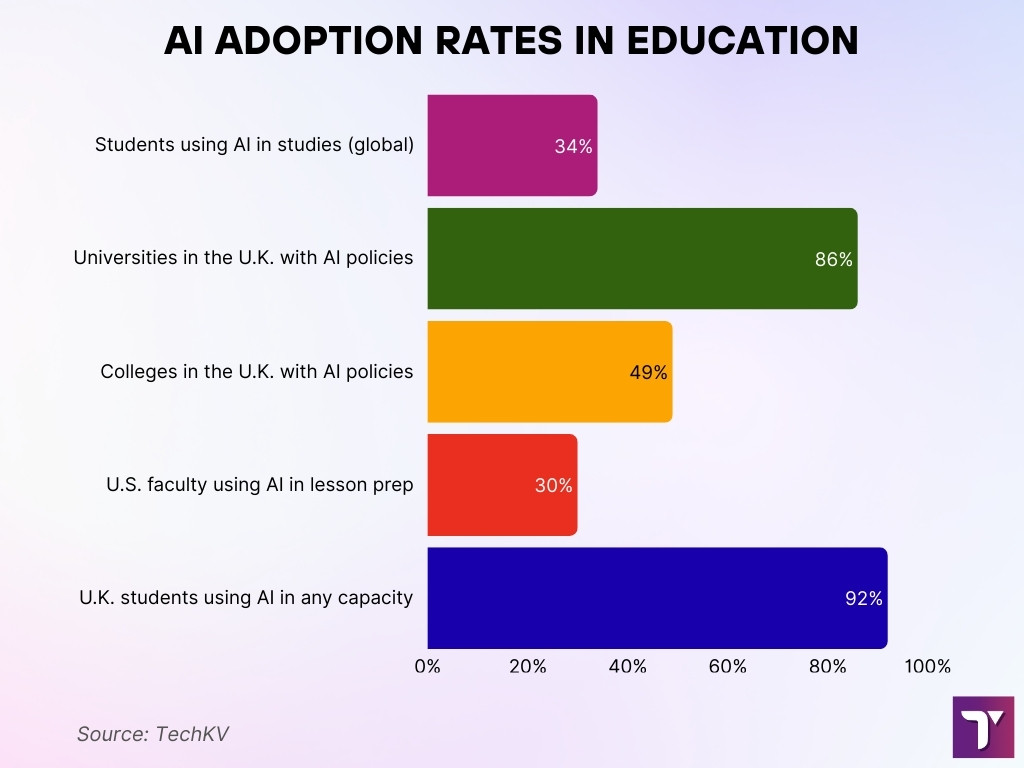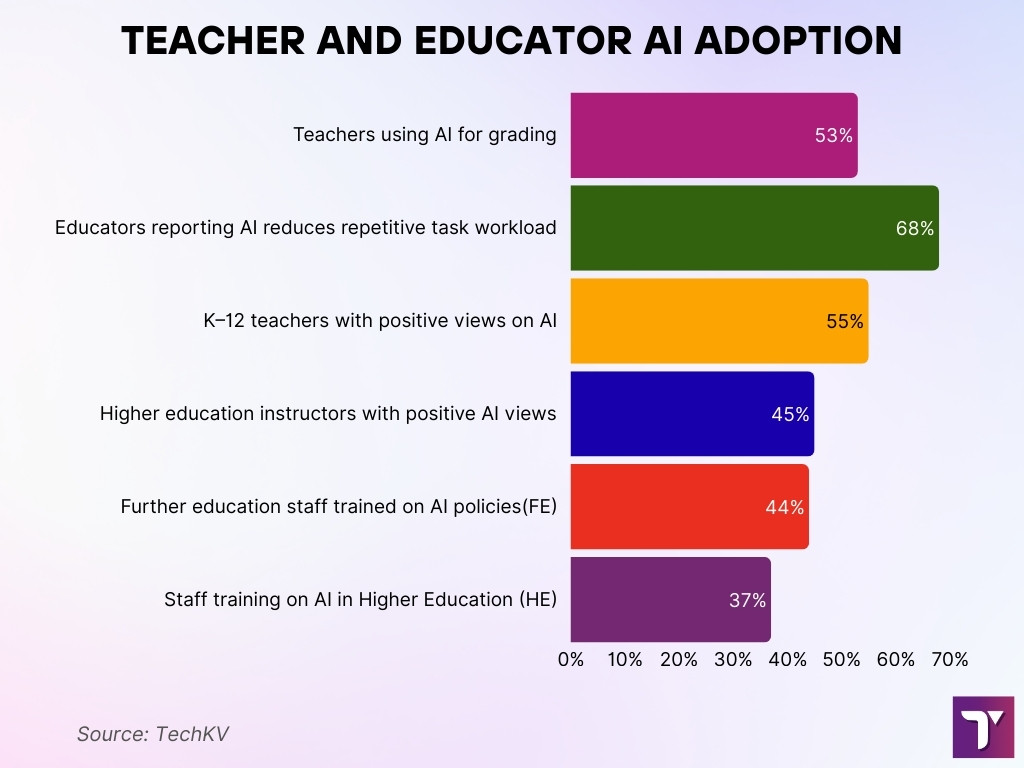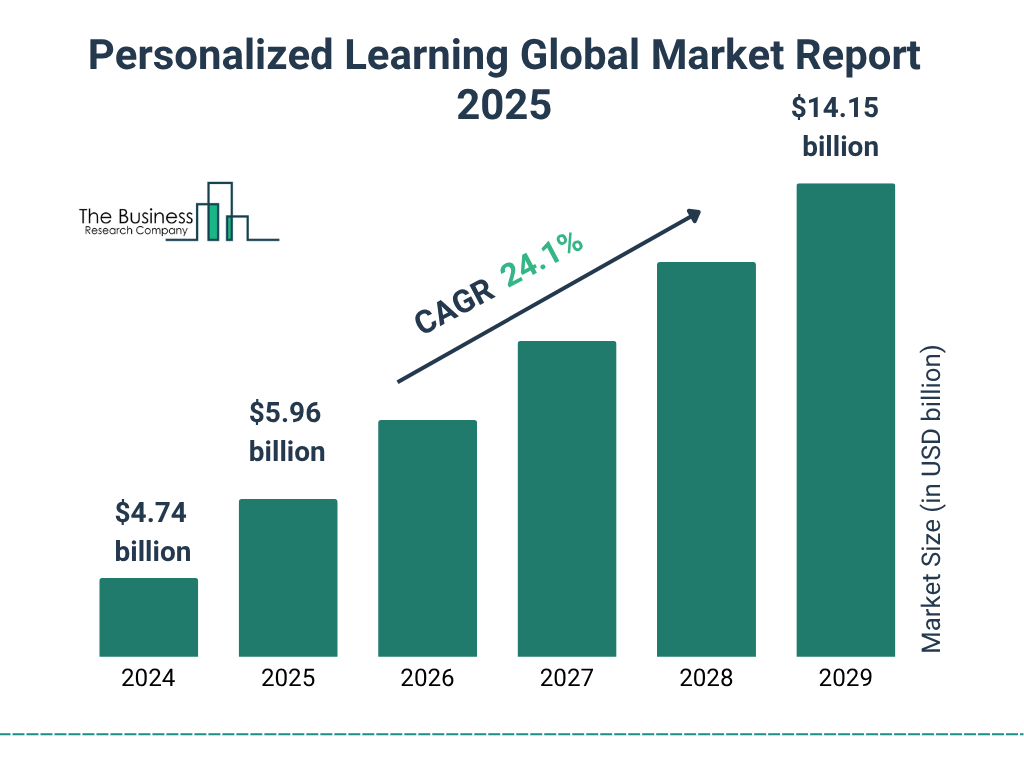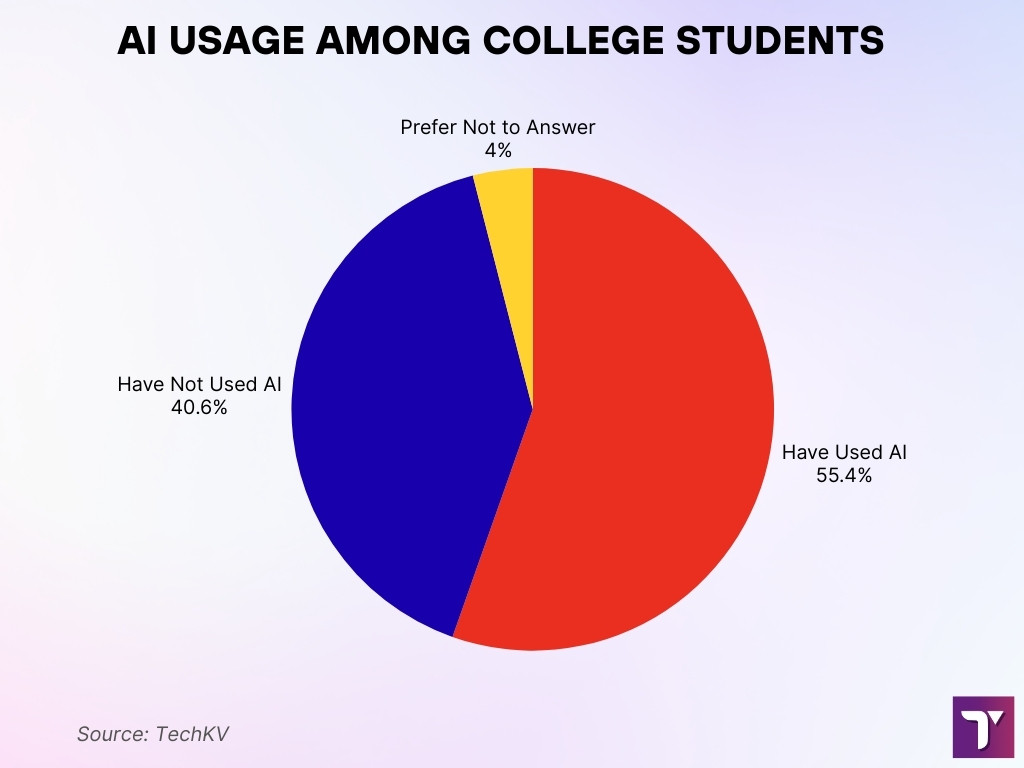Artificial intelligence is reshaping classrooms, campuses, and learning platforms. From personalized study tools for students to grading assistants for teachers, its applications are widespread. Corporations are also embedding AI in workforce training, while schools experiment with AI-driven accessibility to support learners. As adoption grows, the role of AI in equity, efficiency, and ethical education expands.
Editor’s Choice
- The global AI in education market is expected to reach $25.7 billion by 2030, growing at a CAGR of 36.6%.
- 92% of college students in the U.K. now use AI tools regularly, up from 66% in 2024.
- 83.5% of students report that AI improves their learning efficiency, particularly in organizing and accelerating study.
- In U.S. schools, about 71% of elementary institutions now use AI-based learning aids.
- 53% of teachers reported using AI for grading in 2025, up from 31% just three years earlier.
- The AI in K–12 education market is projected to surge from $390.8 million in 2024 to nearly $8 billion by 2033.
- A large-scale meta-analysis showed AI tools have a large positive effect on student performance, with an effect size of g = 0.867.
Recent Developments
- AI adoption in higher education grew significantly in 2024–2025, with institutions piloting generative AI for grading, tutoring, and administrative support.
- In K–12, generative AI integration outpaced higher ed, with 55% of teachers showing positive perceptions compared to 45% in universities.
- Microsoft’s 2025 education report highlighted real-time data use in schools, tracking learning outcomes, and boosting personalization.
- The surge in AI literacy courses reflects demand: 65% of college students believe they know more about AI than their instructors.
- Corporations increasingly tie AI training into professional development, reinforcing higher education’s move to integrate AI curricula.
- Institutions continue to issue policies: Jisc found 86% of universities now have AI policies, yet student clarity lags.
- Pew Research noted rising skepticism: 25% of U.S. K–12 teachers said AI does more harm than good, showing adoption is uneven.
- Global conferences in 2025 emphasized ethics, bias mitigation, and accessibility as core education AI priorities.
AI Adoption Rates in Education
- In 2025, surveys show 34% of students reported using AI in their studies, up from 22% in 2024.
- 86% of universities and 49% of colleges in the U.K. have formal AI policies.
- In the U.S., about 30% of higher education faculty integrate AI tools into lesson preparation.
- 92% of students in the U.K. say they use AI in some capacity, suggesting near-saturation.
- ChatGPT adoption in U.S. teens doubled to 26% in 2025 from 13% in 2023.
- Corporate surveys show 71% of L&D professionals are exploring AI for training and personalized learning.
- In elementary and middle schools, more than 56% report using AI for formative assessments.
- AI adoption in rural or low-income schools remains lower, indicating infrastructure gaps.

AI Market Growth in Education
- The AI in education market is projected to reach $25.7 billion by 2030, with a CAGR of 36.6%.
- The AI in the K-12 segment alone is expected to grow from $390.8 million in 2024 to nearly $8 billion in 2033.
- By 2025, AI tools for assessment and grading will form one of the fastest-growing segments.
- North America accounts for the largest share of global education AI spending, driven by U.S. institutions.
- Asia-Pacific is projected to see the highest CAGR through 2030, fueled by large-scale government investments.
- Corporate e-learning with AI integration is projected to cross $5 billion by 2028.
- Funding in EdTech startups exceeded $2.5 billion in 2024, much of it focused on AI platforms.
- AI demand for personalized content and accessibility solutions is shaping vendor growth strategies.
Student Usage of AI Tools
- 82.4% of students say AI tools improve their academic performance.
- 83.5% say AI increases efficiency in accessing resources and organizing tasks.
- In China, over half of engineering students report that AI boosts creativity and initiative.
- U.K. students: 92% adoption rate, with the biggest gains in task automation and writing support.
- Many students admit to overreliance risks: one study found that some AI users scored 6.7 points lower in exams.
- Teens in the U.S. doubled their school-related AI usage in two years.
- AI is widely used for summarization, exam prep, and feedback, not just homework.
- Corporate learners also increasingly use AI assistants for microlearning and career-focused modules.
Teacher and Educator AI Adoption
- 53% of teachers in 2025 reported using AI in grading.
- 68% of educators said AI reduced workload in repetitive tasks.
- 55% of K–12 teachers expressed positive views on AI, higher than 45% of higher ed instructors.
- Policy awareness varies: while many universities issued AI guidelines, staff training lags behind at 37% in HE and 44% in FE.
- Educators using AI for lesson planning and feedback creation reported significant time savings.
- Concerns remain around AI misuse in exams, with many faculty pushing for assessment redesigns.
- Faculty in higher education report that students expect AI literacy teaching, but adoption into curricula is slow.
- Workload reduction is a key motivator, with AI freeing time for direct student engagement.

Impact of AI on Student Performance
- Large-scale meta-analysis shows AI has positive effects on learning performance (g = 0.867), perception (g = 0.456), and higher-order thinking (g = 0.457).
- 82.4% of students say AI improves academic performance.
- 83.5% confirm AI increases efficiency.
- Experimental trials found AI feedback improved outcomes for low-achieving students but sometimes lowered autonomy.
- High achievers can underperform if limited to generic AI answers.
- Engineering students in China note improved efficiency and creativity, though grades remain largely unchanged.
- EdTech tools like Engageli report test scores rising by ≈54% for AI users.
- Cengage found that 65% of students believe they know more about AI than their professors.
AI in K-12 vs. Higher Education
- K-12 institutions account for 53% of AI deployments, higher ed 39%.
- The K–12 AI market is forecast to grow nearly 20x from 2024 to 2033.
- 55% of K–12 teachers report positive AI perceptions, compared to 45% in universities.
- Adoption in K–12 grew faster year-over-year than in higher ed.
- K–12 emphasizes personalized learning and formative assessment, while higher ed leans on research and analytics.
- 71% of U.S. elementary schools now use AI-based learning aids.
- Higher ed often integrates AI into chatbots, plagiarism detection, and data analytics.
- Growth in K–12 is projected at 38.1% CAGR, faster than higher ed’s.
Personalized Learning with AI
- 82.4% of students credit AI with performance gains.
- 83.5% say AI boosts efficiency by tailoring learning paths.
- AI feedback shows strong benefits for struggling learners.
- Personalized platforms drive market demand in K–12.
- Students report higher engagement when AI adapts content difficulty.
- Many note improved creativity and initiative with AI use.
- Risks exist that personalization may lower rigor for top achievers.
- Institutions warn that implementation requires careful oversight to avoid bias.
Global Personalized Learning Market Growth
- The global personalized learning market is projected to grow from $4.74 billion in 2024 to $14.15 billion by 2029.
- This represents a compound annual growth rate (CAGR) of 24.1%, indicating a rapidly expanding sector within EdTech.
- In 2025, the market is expected to reach $5.96 billion, marking a 25.7% increase over 2024.
- By 2029, the market will have tripled in size compared to 2024, reflecting strong demand for tailored learning experiences.
- The growth is largely driven by AI integration, adaptive learning platforms, and increased investment in digital education solutions.
- Personalized learning is gaining traction in K–12, higher education, and corporate training sectors globally.
- This trend underscores a significant shift toward learner-centric models, with a focus on data-driven customization and outcome-based education.

AI in Administrative and Teaching Tasks
- 90% of universities use AI for administrative tasks.
- 56% of middle schools use AI for real-time formative assessments.
- 68% of teachers say AI grading reduces stress.
- Microsoft’s 2025 report shows widespread use in scheduling and curriculum management.
- Cengage finds more instructors using AI in lesson planning.
- Investment is strong in non-instructional AI services, such as analytics.
- Educators report that AI frees up time for pedagogy.
- Teachers express interest in further automating repetitive tasks.
AI in Assessment and Grading
- 53% of teachers use AI in grading, up from 31% in 2022.
- Studies show AI essay feedback significantly boosts performance.
- But exam misuse can reduce scores by about 6.7 points.
- Integrity concerns push institutions to develop detection tools.
- 56% of urban middle schools use AI for formative assessments.
- AI improves performance for low achievers in trials.
- Students value AI’s speed and personalization in grading.
- Institutions limit AI in high-stakes exams due to fairness concerns.
Equity and Accessibility through AI
- AI supports students with disabilities through speech-to-text and adaptive content.
- Adoption is higher in well-funded districts, creating equity gaps.
- Tools aid non-native speakers with translation and adaptive learning.
- Microsoft stresses the importance of student agency in AI adoption.
- Accessibility tools like captioning and visual aids are expanding.
- Infrastructure gaps in rural and low-income areas persist.
- Bias in AI models can disadvantage certain groups.
- Students believe faculty lack AI knowledge, widening digital divides.
AI for Students with Support Needs
- 7.5 million students in the U.S. received IDEA services in 2022–23, about 15% of enrollment.
- Identification rose from 6.4 million (2012–13) to 7.5 million (2022–23).
- Services vary: 21% of students in Pennsylvania vs 12% in Idaho.
- Microsoft Immersive Reader studies show dyslexic readers achieve 10% faster reading with 50% fewer errors.
- Regular Reading Progress use correlates with higher accuracy in K–6.
- Real-time captioning is a proven model for accessibility.
- Deaf students benefit from live captions in fast-paced classrooms.
- IDEA Part B covers ~7.1 million students aged 5–21.
Student Engagement and Motivation with AI
- Jisc reports that most universities have AI policies, but students lack clarity.
- 34% of students used AI in 2025 vs 22% in 2024.
- Microsoft highlights AI’s role in fostering self-directed learning.
- 92% of students in the U.K. now use AI, up from 66% last year.
- 50% of U.S. students view AI skills as the most important college skill.
- Jisc data shows engagement gains across learning prep, delivery, and reporting.
- Captioning users scored ≈7% higher on assessments.
- U.S. teens’ use of ChatGPT for schoolwork doubled to 26%.
AI Usage Among College Students for Assignments & Exams
- A majority of college students (55.4%) reported that they have used AI tools to help complete assignments or exams.
- 40.6% of students stated they have not used AI in any form for academic work.
- A small portion, 4%, chose to prefer not to answer, indicating possible concerns around academic integrity or privacy.
- The data suggests that AI adoption in academia is now mainstream, particularly among digitally fluent students.
- Popular AI tools used include ChatGPT, Grammarly, Quillbot, and other generative AI platforms.
- This shift reflects a growing reliance on AI-powered assistance in academic environments, raising questions about plagiarism, learning outcomes, and policy regulation.
- Institutions are beginning to revise honor codes and assessment methods to adapt to this new reality.

AI in Corporate Training and Lifelong Learning
- LinkedIn finds career-driven firms are 42% more likely to lead in AI.
- 71% of L&D leaders are piloting AI for personalization.
- McKinsey: 94% of employees and 99% of C-suites report AI familiarity.
- IBM: 89% of leaders say staff need AI skills, but only 6% act on it.
- Governments scale upskilling programs for millions of workers.
- SMEs lag: only 12% invested in AI training.
- 58% of L&D leaders cite skills gaps as a top challenge.
- 83% of firms plan to maintain or grow career-based learning.
Challenges and Concerns in AI Adoption
- Academic integrity pressures drive assessment redesigns.
- 25% of U.S. teachers say AI harms learning.
- Students lack clarity despite institutional policies.
- EDUCAUSE highlights a digital AI divide in strategy.
- Data privacy concerns rose from 50% in 2023 to 59% in 2024.
- Some studies show that misuse lowers grades.
- Business sentiment shows dips in AI use, reflecting hype cycles.
- Students demand participatory governance in AI decisions.
Ethical and Privacy Considerations in AI
- The U.S. Department of Education offers AI guidance and case uses.
- UNESCO urges human-centered AI frameworks, with competency standards issued in 2024.
- EDUCAUSE calls policies and guidelines a core AI priority.
- Experts emphasize autonomy and transparency for students.
- Privacy and bias remain top institutional concerns.
- Only 37% of HE and 44% of FE institutions have trained staff.
- Microsoft notes student agency and equitable access as ethical guardrails.
- Institutions increasingly require disclosure of AI use in assessments.
Future Trends in AI Education
- WEF projects 39% of core skills will change by 2030.
- Coursera tracks surging enrollments in AI-related skills.
- LinkedIn finds career-driven learning speeds AI adoption.
- UNESCO: Two-thirds of HE institutions are developing AI policies.
- Jisc warns student use is rising faster than staff training.
- Governments invest in lifelong upskilling programs.
- Growth in assistive AI will support 15% of U.S. students in special education.
- Expect redesign of assessments with disclosure policies.
Frequently Asked Questions (FAQs)
It was about $5.88 billion in 2024 and is expected to reach $32.27 billion by 2030, with a CAGR of 31.2%.
The global market is projected to grow from $7.05 billion in 2025 to $112.30 billion by 2034, at a CAGR of 36.02%.
78% of K-12 schools in the U.S. report using at least one AI-powered tool in the classroom, and 64% of higher-education institutions have integrated AI in administrative or learning systems.
About 54% of students use AI on a daily or weekly basis, and 86% of students worldwide use multiple AI tools.
Around 60% of educators have adopted AI in classrooms; top use-cases include AI-powered educational games (51%), adaptive learning platforms (43%), and automated grading/feedback systems (41%).
Conclusion
AI is now embedded across classrooms, campuses, and workplaces. Data shows widespread adoption among students, expanding accessibility for learners with disabilities, and rapid growth in corporate training. But challenges remain around ethics, privacy, and integrity. The next phase will demand balanced strategies: transparent policies, staff training, and equitable access. The evidence points to AI as both a driver of efficiency and a test of educational values. The question is no longer whether AI belongs in education, but how we use it responsibly to prepare learners for the future.
